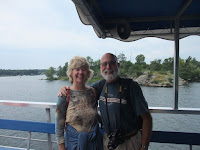Arriving at the capitol of Canada we discovered the Ottawa Municipal Campground in a wooded area fifteen minutes outside the heart of the city. Each day there comes a free shuttle bus from the campground into downtown to a kiosk drop off directly across from Parliament Hill. With a three day city tour bus pass we’ve been able to hop on and off at choice sights. There are more galleries, museums, and exhibition activities than ever.

Ottawa is a city of monuments with an amazing oasis of things to do and see.
Parliament Hill was the first destination for a walk around viewing the numerous monuments around the three Parliament buildings and focal points off in the distance. Touring the interior hallway quarters of the Parliament Building is an architectural delight. It is equivalent to being inside a European castle with its neo-gothic style arches, columns, and gargoyles. The Parliament circular library’s exterior and interior was by far the most impressive feature. The East and West block Parliament Buildings glow green above the city skyline because of their copper roofing. These neo-gothic sandstone buildings were completed in 1860. The Parliament Buildings are distinctly reminiscent of London’s Westminster.
Our first day adventure enjoyed viewing the changing of the guard marching parade on the parliament lawn during the morning.
 |
| Parliament Library Exterior and Interior |
Afterwards we hopped on the top of a double- decked bus for two hours of a narrated tour around the city. It was money well spent and JR was a happy camper free from driving the big city streets. This gave us a chance to decide were we might want to spend more extended time as the tour points out the top belvederes.Departing off the bus at the Info Centre found us gathering booklets for upcoming places in eastern Canada and lunch nearby at an outside pub where pigeons clamor for tidbits.
Watching boats passing through the locks on the Rideau Canal was interesting. Here the system is the only one still done by hand-cranked levers out of the 47 locks along the St. Lawrence River. It costs $250 to pass through the locks on the Rideau Canal from Ottawa to Kingston 225 kilometers with ones boat , but it is said to be well worth it.
On the second and third day we took in the most popular two museums as our visit in Ottawa had allowed for only three days. First off The Museum of Civilizations was so captivating that it took us a full day to tour. The four floors had artifacts and exhibits of aboriginal and first nation people, famous people, horses through the ages, and the history of Canada through the provinces.
In the Grand Hall an alabaster carving at the Civilization Museum
 |
| Flags on Canada Day July 1 at Tomb of the Unknown soldier |
|
|
The Canadian War Museum was also a top ten belvedere. Canadians may have a reputation as a peaceful people but they have seen their share of the world’s battlefields. This museum relocated to a new home on Vimy Place in 2005 and houses the country’s largest military collection.
 |
| World War II Lt. General's Medals |
It displays an excellent overview of the history of Canadian wars from the 1600s to the present. The French, British, and Indian wars on her soil through both world wars to present day peace keeping honor and commemorate the nation’s military history.
Rideau Hall, the official residence and work place of every governor general since 1867, was a delight. The historic site hosts foreign dignitaries and has a magnificent collection of Canadian art and furniture inside the home. The residence is equivalent to the White House and open to the public for tours. Ceremonial sentries, led by a piper, march to their guard posts at the Sussex Entrance Gate every hour on the hour.
Next stop was at Notre Dome Basilica Cathedrale built in 1839. With its twin spires as a landmark, inside it features a spectacular Gothic style ceiling, stain glass windows, ornate altars, wooden carved pews, and granite marble columns and floors.
 |
| Bascila Altar Ceiling | | | | |
|
|
By the end of the last day in Ottawa our sightseeing was almost maxed out. As the shuttle bus pulled back into the campground, several old vintage cars were parked on display at the central lawn area.A group of 97 classic car owners called Coasters 2010 are traveling in their vehicles coast to coast from Nova Scotia to Victoria, British Columbia.

We had loads of fun meeting some these Canadian folks and seeing their classic autos and “Boler” air stream trailers being towed behind for camping. They are on the move traveling daily whereas we make more time to stop and visit wonderful places along the way in our travels.


























































